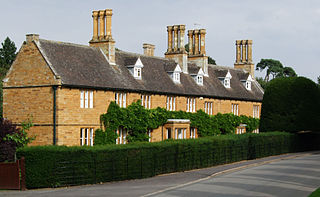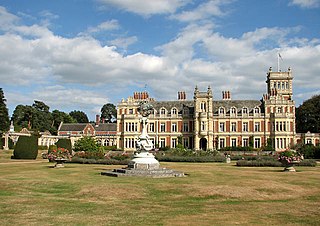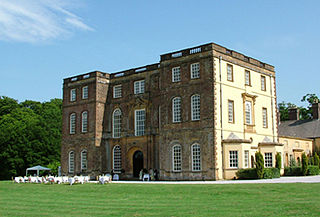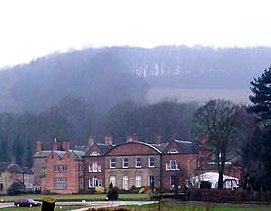
Cottesbrooke Hall and the Cottesbrooke estate in Northamptonshire, England, is a Grade I listed country house and estate. [1]

Cottesbrooke Hall and the Cottesbrooke estate in Northamptonshire, England, is a Grade I listed country house and estate. [1]
The Hall and estate are approx. 10 mi (16 km) north of the town of Northampton along the A5199 road just 1 mile (1.6 km) north of the village of Creaton. The village of Cottesbrooke is adjacent to the estate.
The Hall is a near-perfect example of Queen Anne architecture located in a large parkland setting with wide views across the local countryside. It is constructed in brick with ashlar dressings and lead and slate roofs with a 7-window frontage. [2] The building was begun in 1702 and finished in 1713 by Sir John Langham and remains today largely unaltered, although some extensions were later carried out by Robert Mitchell c1770-95. It is home to the Woolavington Collection, one of the most extensive collections of sporting paintings in the world.
The Hall is set in the 18th century landscaped Cottesbrooke Park, and has fine furniture, the interior decoration, grounds and gardens. It was winner of the Historic Houses Association/Christie's 'Garden of the Year' Award in 2000. [3]
The building and grounds are open from May to September. [4] The times are limited and visitors should book in advance if requiring tours of the house.[ citation needed ] The best route to the visitor entrance is via a signposted turn, east off the A5199 at Creaton.
The Cottesbrooke estate was purchased in 1635 by Sir John Langham, 1st Baronet, a rich London merchant and MP. It descended in the Langham family to the 4th Baronet, who in 1702 began the building of the present hall. Sir James Langham, 7th Baronet was High Sheriff of Northamptonshire for 1767 and MP for Northamptonshire from 1784 to 1790. Sir James, the 11th baronet, had mental disabilities and the estate was managed by Sir Herbert Langham, his brother and eventual successor. In 1877 the Hall was let for several months to the Empress Elisabeth of Austria as a base for a hunting holiday. In 1911 financial pressures forced the family to sell the estate to Captain Robert Bingham Brassey, MP and move to County Fermanagh. Since 1937 Cottesbrooke has been the home of the MacDonald-Buchanan family. [5] In 1937-8 they employed Lord Gerald Wellesley (later the 7th Duke of Wellington) to make alterations to the Hall, including changing the entrance front to the other side of the house.
Cottesbrooke Hall is thought to have been the inspiration for Mansfield Park, the country estate of Sir Thomas Bertram in Jane Austen's 1814 novel Mansfield Park. [6]
The gardens today are entirely 20th century. The architect Robert Weir Schultz, 1860–1951, designed a sunken courtyard garden with a pool and pergola, and a long paved terrace walk between mixed borders and overshadowed by old Lebanon cedars. A pair of 18th century gates lead to pleached limes and a statue of a gladiator. A statue walk with yew hedges has four fine statues by Peter Scheemakers originally in the Temple of Ancient Virtue at Stowe and bought in 1938. South of the house, which was originally the entrance façade, a new garden surrounded by wrought-iron railings was laid out in 1937 by Sir Geoffrey Jellicoe in the form of a quadripartite parterre, with topiary shapes of common and golden yew disposed among lead statues, beds of ‘Iceberg’ roses, and tubs of agapanthus. [7]

Blickling Hall is a Jacobean stately home situated in 5,000 acres of parkland in a loop of the River Bure, near the village of Blickling north of Aylsham in Norfolk, England. The mansion was built on the ruins of a Tudor building for Sir Henry Hobart from 1616 and designed by Robert Lyminge. The library at Blickling Hall contains one of the most historically significant collections of manuscripts and books in England, containing an estimated 13,000 to 14,000 volumes. The core collection was formed by Sir Richard Ellys. The property passed into the care of the National Trust in 1940.

Lamport Hall in Lamport, Northamptonshire is a fine example of a Grade I Listed House. It was developed from a Tudor Manor but is now notable for its classical frontage. The Hall contains an outstanding collection of books, paintings and furniture. The building includes The High Room with a magnificent ceiling by William Smith. It also has a library with 16th-century volumes and an early 19th-century cabinet room with Neapolitan cabinets which depict mythological paintings on glass. It is open to the public.

Easton Neston is a large grade I listed country house in the parish of Easton Neston near Towcester in Northamptonshire, England. It was built by William Fermor, 1st Baron Leominster (1648–1711), in the Baroque style to the design of the architect Nicholas Hawksmoor.

Welford is a village and civil parish in the West Northamptonshire unitary authority area of Northamptonshire, England, just south of the River Avon and the border with Leicestershire. At the 2011 Census, the population of the parish was 1,043.

Spratton is a village and civil parish in the English county of Northamptonshire. The local government authority is West Northamptonshire. Before changes in 2021 it was governed by Daventry District Council. At the time of the 2001 census, the parish's population was 1,099 people, increasing to 1,150 at the 2011 Census. Spratton is 7.1 miles north of Northampton, 6.5 miles from Long Buckby and 11.4 miles from Daventry. The village is situated on the A5199 road.

Creaton is a village and civil parish in West Northamptonshire, England.

Cottesbrooke is a village and civil parish in West Northamptonshire in England. At the time of the 2001 census, the parish's population was 144 people, falling marginally to 143 at the 2011 census.

Clevedon Court is a manor house on Court Hill in Clevedon, North Somerset, England, dating from the early 14th century. It is owned by the National Trust and is designated as a Grade I listed building.

Somerleyton Hall is a country house and 5,000-acre (2,000 ha) estate near Somerleyton and Lowestoft in Suffolk, England owned and lived in by Hugh Crossley, 4th Baron Somerleyton, originally designed by John Thomas. The hall is Grade II* listed on the National Heritage List for England, and its landscaped park and formal gardens are also Grade II* listed on the Register of Historic Parks and Gardens. The formal gardens cover 12 acres (4.9 ha). Inspired by Knepp Wildland, Somerleyton is rewilding 1,000 acres (400 ha) of the estate to which he has introduced free-roaming cattle, large black pigs and Exmoor ponies.
This is a list of the High Sheriffs of Northamptonshire.

Coade stone or Lithodipyra or Lithodipra is stoneware that was often described as an artificial stone in the late 18th and early 19th centuries. It was used for moulding neoclassical statues, architectural decorations and garden ornaments of the highest quality that remain virtually weatherproof today.

Halswell House is a Grade I listed country house in Goathurst, Somerset, England.
The Langham Baronetcy, of Cottesbrooke in the County of Northampton, is a title in the Baronetage of England. It was created on 7 June 1660 for John Langham, Member of Parliament for the City of London in 1654 and for Southwark in 1660 and 1661. The second Baronet was Member of Parliament for Northamptonshire and Northampton while the third Baronet sat for Northampton. The seventh Baronet was Member of Parliament for Northamptonshire. The tenth Baronet represented St Germans in the House of Commons. The thirteenth Baronet was a photographer, ornithologist and entomologist and served as High Sheriff of County Fermanagh in 1930.
Sir Herbert Charles Arthur Langham, 13th Baronet was an English landowner, photographer, ornithologist and entomologist.
Highgate House was an important Northamptonshire coaching inn and Royal Mail posting station at the village of Creaton, on the Northampton to Leicester road, dating from 1663. The building, much expanded and adapted, is now used as a country house hotel and conference venue, but retains its original appearance and character.

Hopton Hall is an 18th-century country house at Hopton, near Wirksworth, Derbyshire. It is a Grade II listed building.

Hardwick House was a manor house near Bury St Edmunds, Suffolk, owned by Sir Robert Drury, Speaker of the House of Commons, of Hawstead Place. It was subsequently purchased in the seventeenth century by Royalist Robert Cullum, a former Sheriff of London. Experts in Suffolk county history as well as noted authorities in antiquarian and botanical matters, the Cullum family of eight successive baronets authored works on the county and its fauna and flora. Sir Thomas Gery Cullum, a Charterhouse graduate, medical doctor and member of the Royal Academy and the Linnean Society, was a well-regarded author on science and botany.

Tapeley is a historic estate in the parish of Westleigh in North Devon, England.
Sir James Langham, 2nd Baronet of Cottesbrook, Northamptonshire was an English politician who sat in the House of Commons at various times between 1656 and 1662. He married four times, but he had no heir.
Edward Ayshford Sanford was a British Member of Parliament.